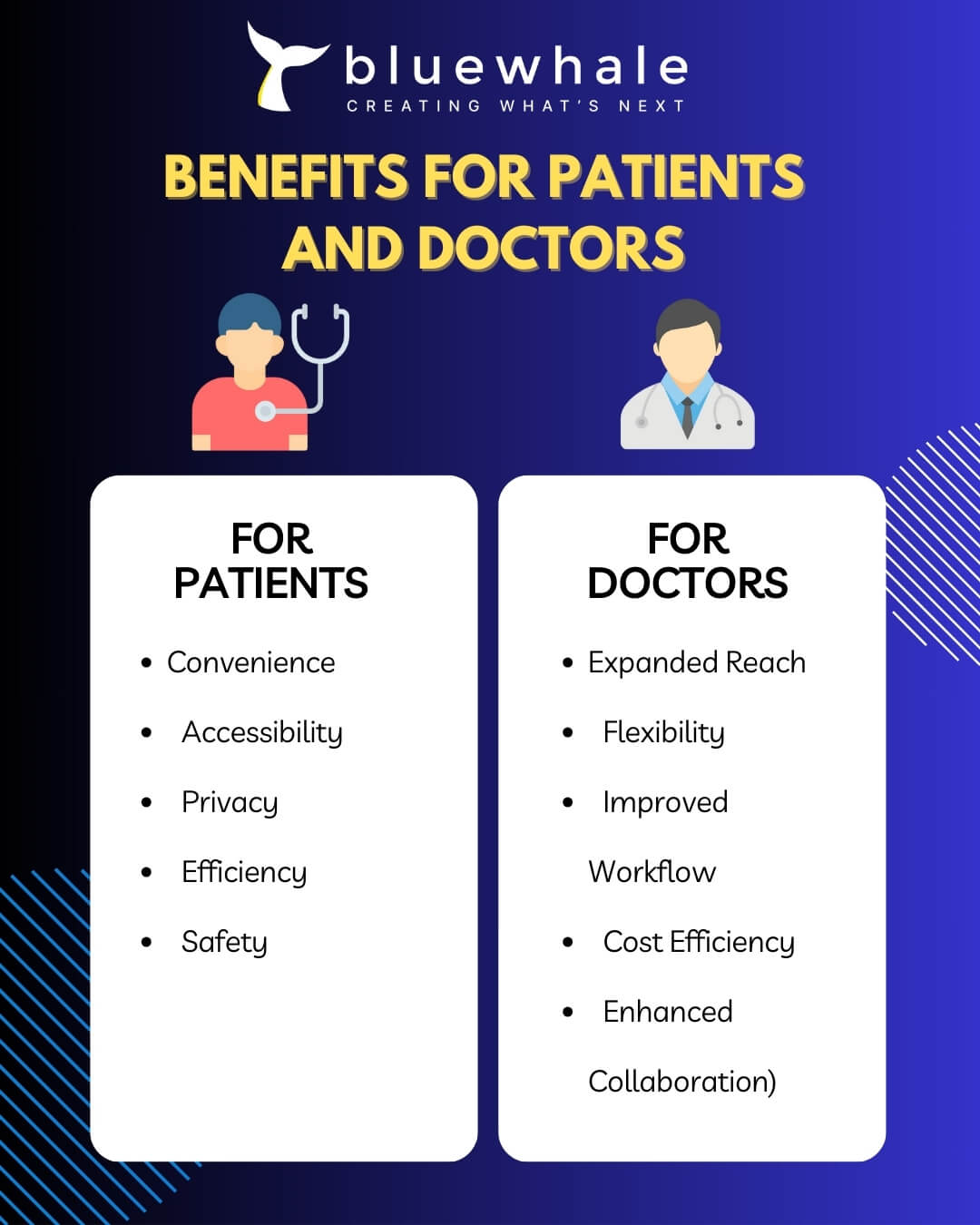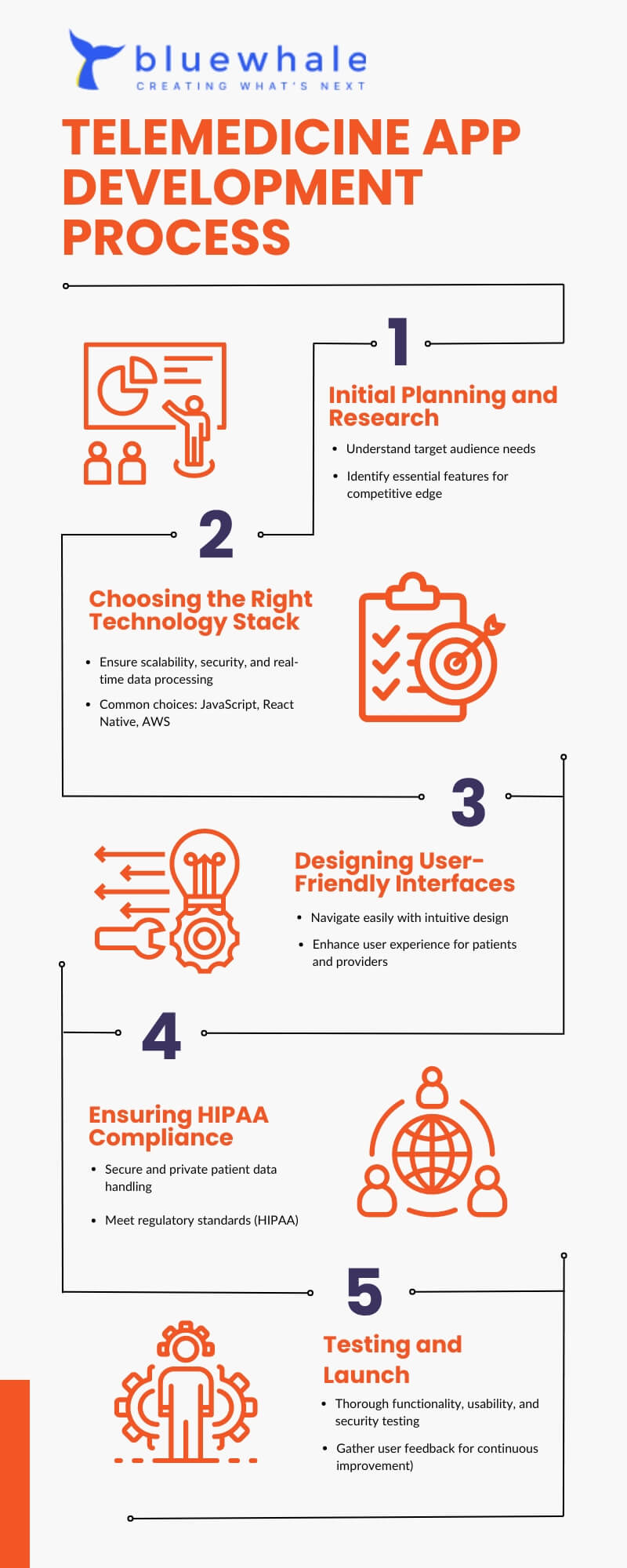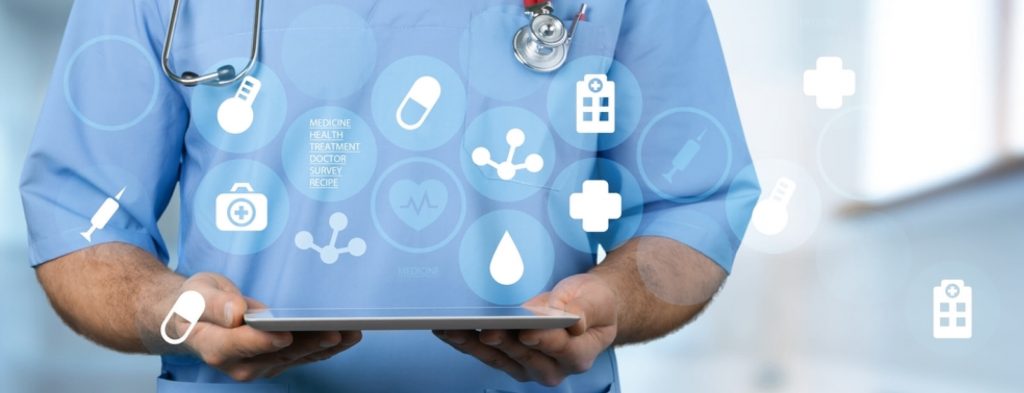Introduction to Telemedicine App Development
What is Telemedicine?
Telemedicine refers to the practice of using telecommunications technology to provide medical care and services remotely. This can include video consultations, remote patient monitoring, and digital transmission of medical information. For more information on how healthcare apps are developed, check out our healthcare app development page.
Telemedicine allows healthcare professionals to diagnose, treat, and follow up with patients without requiring physical presence. This method is ideal for individuals living in remote areas. It is also beneficial for those with mobility issues. Additionally, it is useful during public health emergencies when in-person visits are not feasible.
The core components of telemedicine include:
- Video Consultations: Real-time video interactions between patients and healthcare providers, allowing for visual assessments and discussions.
- Remote Monitoring: Devices track patient health metrics like blood pressure or glucose levels and send data to healthcare providers.
- Digital Communication: Secure messaging platforms for sending and receiving medical information, prescriptions, and follow-up care instructions.
Telemedicine is transforming healthcare by increasing access to medical services, improving the efficiency of care delivery, and enhancing patient outcomes.
Telemedicine Market and Its Future in the United States
The telemedicine market in the United States has experienced significant growth, particularly in response to the COVID-19 pandemic. This growth is caused by better technology, new rules, and more people wanting easier healthcare choices.
Current Telemedicine Market Overview
By 2032, the United States could face a big problem: not having enough doctors. Experts predict there could be a shortage of 46,900 to 121,900 physicians.
A report by Mordor Intelligence™ predicts that the telemedicine market will reach $172.44 billion in 2024. It is expected to grow to $330.26 billion by 2029. The market is projected to have a growth rate of 13.88% annually from 2024 to 2029.
The market is projected to have a growth rate of 13.88% annually from 2024 to 2029. This growth reflects the emergence of telemedicine in the healthcare sector, spurred by the COVID-19 pandemic.
This growth is attributed to several factors:
- Increased Adoption: More people started using telemedicine during the pandemic to stay safe while getting medical care.
- Technological Advancements: Innovations in communication technologies, such as high-speed internet and mobile health apps, have made telemedicine more accessible and user-friendly.
- Regulatory Support: Changes in healthcare policies, including temporary waivers on telehealth restrictions and increased reimbursement rates for telemedicine services, have supported the market expansion.
Future Prospects
The future of telemedicine in the United States looks promising, with several key trends expected to shape the market:
- Integration of AI and Machine Learning: AI and machine learning will improve telemedicine by providing better diagnoses, personalized treatment, and predictive analysis.
- Expansion of Telehealth Services: Telehealth services are expanding to include more than just medical consultations. They will now also cover mental health counseling, physical therapy, and remote surgeries.
- Focus on Chronic Disease Management: Telemedicine will help manage chronic diseases by monitoring patients regularly and providing timely care. This will improve patient health and lower healthcare expenses.
- Enhanced User Experience: Telemedicine consultations will be more engaging and interactive with the combination of augmented reality (AR) and virtual reality (VR) technologies. This will lead to improved user experience and better outcomes.
Challenges and Considerations
Despite its growth, the telemedicine market faces several challenges:
- Regulatory and Compliance Issues: Following healthcare regulations like HIPAA is crucial for protecting patient privacy and data security. Compliance with these rules is necessary to avoid regulatory and legal issues.
- Data Security and Privacy: Protecting patient data from cyber threats and breaches is a top priority for telemedicine providers.
- Integration with Existing Healthcare Systems: Linking telemedicine platforms with electronic health records and other healthcare systems can be complex and requires careful planning for smooth integration.
Importance of Telemedicine in 2024

Understanding Telemedicine App Development
Telemedicine apps come in various forms, each designed to address specific healthcare needs. To dive deeper into the different types of healthcare apps and their development processes, visit our healthcare app development guides.
Types of Telemedicine Apps
- Video Consultation App
- Remote Patient Monitoring App
- Store-and-Forward App
- mHealth (Mobile Health) App
- Provider-Focused Platform
- Mental Health App
- Specialty-Specific App
- Emergency Telemedicine App
- Telemedicine Kiosk App
- AI-Powered Diagnostic App
- Chronic Disease Management App
- Pediatric Telemedicine App
- Teletherapy App (for physical therapy, occupational therapy, etc.)
- Teledermatology App
- Telenursing App
Key Features of a Telemedicine App
| Feature | Description |
| Video consultation | High-quality, secure video calling for virtual appointments |
| Appointment scheduling | Easy-to-use interface for booking and managing appointments |
| Secure messaging | HIPAA-compliant chat function for doctor-patient communication |
| Electronic health records | Integration with EHR systems for seamless access to patient data |
| E-prescriptions | Ability for doctors to prescribe medications remotely |
| Payment integration | Secure payment processing for consultations and services |
| Multi-device support | Functionality across smartphones, tablets, and computers |
| File sharing | Capability to share medical documents, test results, and images |
| Symptom checker | AI-powered tool to help patients assess their symptoms |
| Remote monitoring | Integration with wearables and health devices for real-time data |
| Specialist referrals | In-app system for referrals to specialists when needed |
| Telemedicine etiquette guide | Instructions for patients on how to prepare for virtual visits |
| Multi-language support | Options for consultations in various languages |
| Emergency services integration | Quick access to emergency services if urgent care is needed |
| Feedback and rating system | Tool for patients to rate and review their telemedicine experience |
Benefits for Patients and Doctors
Telemedicine apps bridge the gap between patients and healthcare providers. Patients save time and travel costs, while doctors can manage more appointments efficiently. This convenience enhances patient satisfaction and improves healthcare outcomes.

Benefits for Patients:
- Improved access to healthcare, especially for rural or mobility-limited patients
- Reduced travel time and costs
- Shorter wait times for appointments
- Easier access to specialists
- Increased privacy for sensitive health issues
- Reduced exposure to contagious illnesses in waiting rooms
- More frequent check-ins for chronic condition management
- Convenience of consultations from home or work
- Easier inclusion of family members in healthcare discussions
- Access to second opinions without extensive travel
Benefits for Doctors:
- Increased patient reach and practice growth
- More flexible work schedules
- Reduced overhead costs for physical office space
- Improved work-life balance
- Easier management of follow-up appointments
- Decreased no-show rates
- Enhanced ability to monitor chronic conditions
- Opportunity to offer more cost-effective care
- Reduced risk of exposure to infectious diseases
- Ability to collaborate more easily with other healthcare professionals
Technical Tools for Telemedicine App Development
- Programming Languages and Frameworks:
- JavaScript: Widely used for front-end development in web-based telemedicine apps.
- React Native: Allows cross-platform development for iOS and Android apps, reducing development time and costs.
- Swift (for iOS) and Kotlin (for Android): Native programming languages for developing platform-specific telemedicine apps.
- Cloud Computing Services:
- AWS (Amazon Web Services): Provides scalable cloud infrastructure for storing and processing healthcare data securely.
- Google Cloud Platform (GCP) and Microsoft Azure: Alternative cloud platforms offering similar capabilities for telemedicine app hosting and data management.
- Real-Time Communication APIs:
- WebRTC (Web Real-Time Communication): Enables real-time video and audio communication between patients and healthcare providers directly within the app.
- Twilio: Provides APIs for integrating voice, video, and messaging functionalities into telemedicine apps.
- Electronic Health Records (EHR) Integration:
- HL7 (Health Level Seven International): Standards for integrating EHR systems with telemedicine platforms, ensuring seamless access to patient data.
- FHIR (Fast Healthcare Interoperability Resources): Modern standard for exchanging healthcare information electronically, facilitating secure data sharing in telemedicine apps.
- Security and Compliance Tools:
- HIPAA-compliant Hosting Services: Ensures telemedicine apps meet regulatory standards for protecting patient privacy and data security.
- Encryption Technologies: Implement end-to-end encryption to secure sensitive medical information transmitted between patients and healthcare providers.
- Development and Collaboration Tools:
- Git and GitHub: Version control and collaboration platform for managing codebase changes and team collaboration in telemedicine app development.
- Slack and Microsoft Teams: Communication tools for real-time collaboration, project management, and team coordination during app development cycles.
Steps to Develop a Telemedicine App
Step-by-Step Guide
Initial Planning and Research
Start with thorough research to understand the needs of your target audience. Identify the essential features and functionalities your app must have to stand out in the competitive market.
Choosing the Right Technology Stack
Select a technology stack that supports scalability, security, and real-time data processing. Common choices include JavaScript, React Native, and cloud-based services like AWS.
Designing User-Friendly Interfaces
A user-friendly interface is crucial for the success of a telemedicine app. Make sure the app is easy to use, with simple design features that improve the experience for patients and healthcare providers.
Ensuring HIPAA Compliance
Compliance with the Health Insurance Portability and Accountability Act (HIPAA) is mandatory for telemedicine apps in the USA. This ensures that patient data is secure and private, meeting all regulatory standards.
Testing and Launch
Thoroughly test the app for functionality, usability, and security issues. Once testing is complete, launch the app and gather user feedback for continuous improvement.

Telemedicine App Development Costs
Telemedicine app development costs can vary significantly based on several factors such as complexity, features, and the development team’s location. Here’s a detailed breakdown of the costs, including country and region-wise estimates:
Factors Affecting Costs:
- App complexity and features
- Platform (iOS, Android, or both)
- Design quality
- Backend infrastructure
- Integration with other systems (EHR, payment gateways)
- Compliance with healthcare regulations (e.g., HIPAA)
- Development team’s expertise and location
Here’s a table showing estimated costs by country/region:
| Country/Region | Estimated Cost Range (USD) | Hourly Rate Range (USD) |
| USA/Canada | $80,000 – $250,000+ | $100 – $250 |
| Western Europe | $60,000 – $180,000 | $70 – $150 |
| Eastern Europe | $40,000 – $120,000 | $35 – $75 |
| India | $30,000 – $80,000 | $25 – $50 |
| Southeast Asia | $35,000 – $90,000 | $30 – $60 |
| Latin America | $45,000 – $120,000 | $40 – $80 |

Cost Breakdown by Development Phase:
- Planning and Research: 5-10% of total budget
- Design: 10-15%
- Development: 50-60%
- Testing and Quality Assurance: 15-20%
- Deployment and Launch: 5-10%
Additional Costs to Consider:
- Ongoing maintenance and updates: $5,000 – $20,000 per year
- Server and infrastructure costs: $200 – $1,000+ per month
- Compliance and security audits: $5,000 – $20,000 per audit
- Marketing and user acquisition: Varies widely, often 20-50% of development cost
Keep in mind that these are rough estimates and actual costs can vary based on specific project requirements. A basic telemedicine app might cost around $40,000-$60,000, while a feature-rich, enterprise-grade solution could exceed $250,000.
To optimize costs:
- Start with a Minimum Viable Product (MVP)
- Use cross-platform development frameworks
- Leverage open-source technologies
- Consider outsourcing to regions with lower rates
- Plan thoroughly to avoid costly changes mid-development
Remember, while cost is important, prioritize quality and compliance when developing a healthcare application. The cheapest option may not always be the best in the long run, especially when dealing with sensitive medical data and potentially life-critical functionality.
Why Invest in Telemedicine App Development?
Investing in telemedicine app development offers significant advantages in today’s healthcare landscape:
- Expanded market reach: Access patients beyond geographical limitations
- Increased revenue streams: Offer new services and monetization options
- Improved patient engagement: Provide convenient, accessible healthcare solutions
- Enhanced operational efficiency: Streamline appointment scheduling and follow-ups
- Cost reduction: Minimize overhead expenses associated with physical clinics
- Competitive advantage: Stay ahead in the rapidly evolving digital health sector
- Data-driven insights: Gather valuable patient data for personalized care
- Scalability: Easily expand services without significant infrastructure investments
- 24/7 availability: Offer round-the-clock care options for patients
- Improved health outcomes: Enable regular check-ins and better chronic disease management
- Pandemic preparedness: Ensure continuity of care during health crises
- Patient satisfaction: Meet growing consumer demand for digital health solutions
- Reduced no-shows: Decrease missed appointments with convenient virtual options
- Specialist accessibility: Connect patients with experts regardless of location
- Innovative care models: Enable new approaches like remote monitoring and virtual wards
Conclusion
Telemedicine app development in 2024 is a fast-growing and changing area. By planning carefully and following rules, you can create a telemedicine app that benefits both patients and healthcare providers. To stay competitive and effective, it’s important to keep learning about the latest trends and challenges in this expanding field.
The need for healthcare you can get from home is growing fast. This means there are many chances to create new and helpful medical apps. At Blue Whale Apps, we’re leading the way in this new world of digital health. We specialize in telemedicine app development, helping to bring doctor visits right to your phone or computer. Our team knows how to make apps that are easy to use for both doctors and patients. We’re excited to help make healthcare more accessible for everyone through smart, user-friendly apps.
Need a telemedicine app that’s easy to use and keeps your information safe?
We can build one for you! We focus on what users want and make sure everything is secure. If that sounds like what you’re looking for, let’s chat! Schedule a call with our team today.
FAQs
What are the key features of a telemedicine app?
Key features include video calls, real-time interaction, remote monitoring, patient data management, and compliance with healthcare regulations.
How much does it cost to develop a telemedicine app?
The cost varies based on feature complexity, development time, and ongoing maintenance. It can range from $50,000 to several hundred thousand dollars.
What are the main challenges in telemedicine app development?
Challenges include regulatory compliance, data security, and integration with existing healthcare systems.
How does telemedicine benefit healthcare professionals and patients?
Telemedicine saves time, reduces travel costs, and provides more efficient patient management. It improves access to healthcare and enhances patient satisfaction.
What future trends should we expect in telemedicine?
Expect advancements in AI, machine learning, AR/VR, and the expansion of telehealth services to include more diverse healthcare solutions.








